

Untitled. 45 Design Thinking Resources for Educators. Imagine a world where digital learning platforms help adult learners succeed through college completion; where a network of schools offers international-quality education, affordable tuition, and serves hundreds of thousands of children in economically disadvantaged countries; where we engage parents in understanding national trends and topics in education; where a comprehensive learning environment seamlessly connects the classroom with the opportunities of the digital world for young students; and where system-level solutions help more students gain access to college.
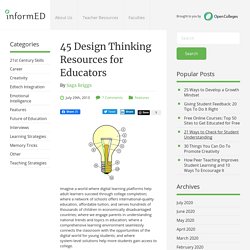
Educators across the world have been using design thinking to create such a world. Design thinking consists of four key elements: Defining the Problem, Creating and Considering Multiple Options, Refining Selected Directions, and Executing the Best Plan of Action. The POEMS Method for User Observation/Research – Template & How-To. Welcome to our series on Design Thinking methods and activities. You’ll find a full list of posts in this series at the end of the page.
POEMS stands for People, Objects, Environments, Messages, and Services. This exercise provides a simple framework for quick and surprisingly deep user observation. 1. Identify Your Subjects & Location We do user observation to understand the people who will be using the software we’re about to create. Whenever possible, do this out in the real world Go to where the end users are trying to accomplish whatever it is that you want to help them do better. 2.
Untitled. ¿Qué es?
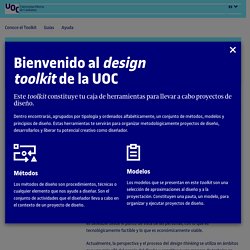
Food Design Studio focused on the Food innovation. Food Design Studio focused on the Food innovation. What Is Insight? The 5 Principles of Insight Definition - Thrive. As customer experiences take center stage so does the need for more profound and compelling insight definition. Insights form the cornerstone of the design and innovation process, a lighthouse for what you should do next, and a catalyst for creating new value for your customers.
The ever-increasing explosion of data puts more knowledge at our fingertips than ever before, but you need to know what to do with it. Otherwise, it is obsolete and ineffective. The Four Planets – The Product Experience Playbook. This website is best experienced as a printed book that you receive when you join us at Automattic Design.
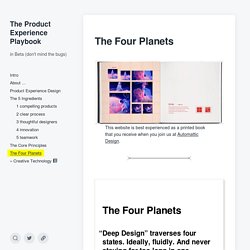
“Deep Design” traverses four states. Ideally, fluidly. And never staying for too long in one particular state of being. We liken it to Pablo Picasso’s dynamic work of Light Paintings. Design thinking courses and certifications - Enterprise Design Thinking. (36) Design Thinking: A Problem Solving Framework. (36) Design Thinking with Elementary Students (1st Grade) Design Toolkit. Open Design Kit. Design Fiction as Pedagogic Practice - matthewward - Medium. Over the last couple of years, the term Design Fiction (DF) has gained ground and popularity.
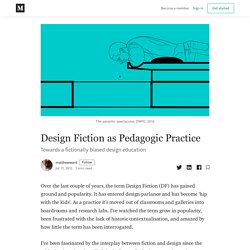
It has entered design parlance and has become ‘hip with the kids’. As a practice it’s moved out of classrooms and galleries into boardrooms and research labs. I’ve watched the term grow in popularity, been frustrated with the lack of historic contextualisation, and amazed by how little the term has been interrogated. Service Innovation & Design. I have been thinking about writing this article for so long that I haven’t yet found a proper start.
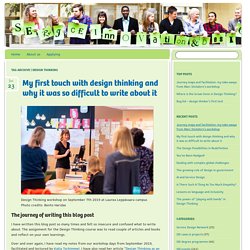
I guess my fear of failing has been always too high in my personality, too many expectations about myself and from others and my natural inclination for perfection hasn’t really helped me in the past. In this moment I recall in my head the words of professor Katja Tschimmel, who held a lecture in Design Thinking at the SID Master Program: “Perfection is the enemy of creativity” Tschimmel, K. 2019. — Official Website. Design Thinking Methods Catalogue. 15 métodos que podemos utilizar dentro del Design Thinking. Design Thinking 101. History of Design Thinking It is a common misconception that design thinking is new.

Design has been practiced for ages: monuments, bridges, automobiles, subway systems are all end-products of design processes. Throughout history, good designers have applied a human-centric creative process to build meaningful and effective solutions. In the early 1900's husband and wife designers Charles and Ray Eames practiced “learning by doing,” exploring a range of needs and constraints before designing their Eames chairs, which continue to be in production even now, seventy years later. 1960's dressmaker Jean Muir was well known for her “common sense” approach to clothing design, placing as much emphasis on how her clothes felt to wear as they looked to others. These designers were innovators of their time. Despite these (and other) early examples of human-centric products, design has historically been an afterthought in the business world, applied only to touch up a product’s aesthetics.
Design Thinking en Español. El Design Thinking se desarrolla siguiendo un proceso en el que se ponen en valor los que nosotros consideramos sus 5 características diferenciales: La generación de empatía: hay que entender los problemas, necesidades y deseos de los usuarios implicados en la solución que estamos buscando.
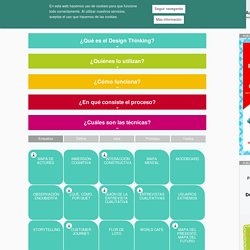
Independientemente de qué estemos desarrollando, siempre conllevará la interacción con personas. Satisfacerlas es la clave de un resultado exitoso. El trabajo en equipo, ya que pone en valor la capacidad de los individuos de aportar singularidad. La generación de prototipos, ya que defiende que toda idea debe ser validada antes de asumirse como correcta. Desarrollo e Impacto, ¡Ya. Three methods of creative thinking you can use to achieve better brainstorming - WE CAN CREATIVE. One of the benefits of being a smaller agency is how much weight everyone’s ideas have.

Here, everyone’s voice and opinions matter. We spent a day reviewing the past year’s performance. Highs, lows, and what worked, and why. We updated the team with our goals, and plan for success in for the coming year. We also pay close attention to continued professional development. Problem Framing v2: Part 4 of 4 - New Haircut. In Part 1 of this series on problem framing, we covered Step 1 of 5 — Problem Discovery.
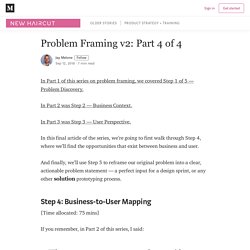
In Part 2 was Step 2 — Business Context. In Part 3 was Step 3 — User Perspective. In this final article of the series, we’re going to first walk through Step 4, where we’ll find the opportunities that exist between business and user. And finally, we’ll use Step 5 to reframe our original problem into a clear, actionable problem statement — a perfect input for a design sprint, or any other solution prototyping process. Stanford d.school: The Bootcamp Bootleg. The Bootcamp Bootleg is a working document published through the Hasso Plattner Institute of Design at Stanford (also known as the d.school) that describes the Stanford Design Thinking Process.

This process can be used for an innumerable amount of problems that apply to several different kinds of stakeholders and industries. In other words, the Stanford Design Thinking Process applies to adopting competency-based education as well as many other things. Therefore, the process that is described below speaks more generally than the two other processes summarized in this paper. Dschool bootleg deck 2018 final sm (2) METHODCARDS v3 slim. What is Ideation – and How to Prepare for Ideation Sessions. Ideation is the process where you generate ideas and solutions through sessions such as Sketching, Prototyping, Brainstorming, Brainwriting, Worst Possible Idea, and a wealth of other ideation techniques. Ideation is also the third stage in the Design Thinking process. Although many people might have experienced a “brainstorming” session before, it is not easy to facilitate a truly fruitful ideation session.
Template Random Links. Problem Framing v2: Part 4 of 4 - New Haircut. 10 Ideation Techniques And Methods – Oz Content. The oversaturation of info on the web means that coming up with great content ideas is more important than ever. But it’s also starting to seem harder than ever to churn out consistently good ideas. Sure, the easy access to pervasive tools like Google means that you can find whatever you’re looking for right when you’re looking for it. But this convenience has also made us a bit lazy when it comes to our ideation techniques. Let’s not forget that Google is a search engine run by a single entity. Think of how many people are pulling from the same resource when it comes to thinking of new ideas and solutions – it’s sort of hard to wrap our heads around what that means for creativity today and how this is creating a world that is saturated with sort of generic ideation. But, fear not. Ideation Technique 1: Challenge existing assumptions. Assumptions can be total anathema to innovation.
As an adult, I realized that we erroneously apply this same principle almost every day. Ideation Method: Mash-Up. "From Ideas to Action" Course Activity & Worksheet Any great ideation session begins with a well-framed opportunity. We use something we call “How Might We” statements—an optimistic, solutions-oriented starting point. It’s critical that a How Might We statement allows for a broad set of solutions, but is narrow enough that we know where to start.
For example, in a challenge around improving the patient experience at a hospital, one of our ideation sessions began with “How might we better support patients’ families in the hospital?” Once the How Might We statement is defined, teams typically race to generate ideas. Design Thinking 101 — The Double Diamond Approach (Part II of II) At SEEK, in preparation for our upcoming 8th Hackathon, we introduced Upskill sessions to teach fellow seekers new skills to help their hacking endeavours.
We kicked off these sessions with a 2-part Design Thinking workshop to broadly share Design Thinking with the rest of SEEK and promote a customer-centric approach in everything we do. In part 1 we gave an overview of what Design Thinking is. This week we dive into the practical exercises we taught in the workshops. We use the Double Diamond structure to understand customers and their problems and explore creative and innovative ways to solve their problems and delight them.
: designing the next – Innovation, User Experience and Digital. The Design Process: What is the Double Diamond? Designers across disciplines share strikingly similar approaches to the creative process, which we’ve mapped out as ‘the Double Diamond’. Every design specialism has a different approach and ways of working, but there are some commonalities to the creative process. At the Design Council we like to illustrate this with our Double Diamond model, part of our Framework for Innovation. © Image Copyright: Design Council 2014 Divided into four distinct phases – Discover, Define, Develop and Deliver – the Double Diamond is a simple visual map of the design process. Teamwork with brains: More difficult than you think. Divergent and Convergent Thinking in the Ideation Process. Design Thinking Archive - Designorate. Home - Gamestorming. Productos Archive - Effective teamwork tools - Manual Thinking.